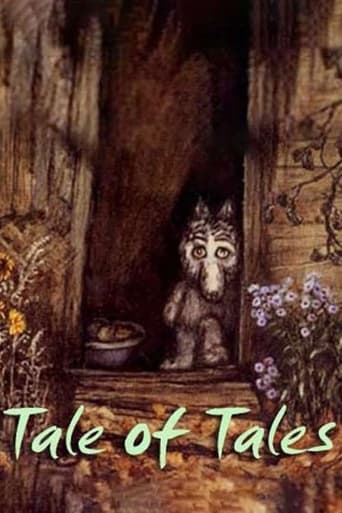Eumenides_0
This movie exists pretty much in its own world. It's not enough to say that this is an animated movie and so exists in a fantasy world. Many animated movies exist in quite realistic worlds, with just a few exaggerations. No, this movie is to the worlds of animation what the worlds of animation are to our world. It's a dream world, purely abstract, about feelings and nostalgia and sadness and confusion and even humor.It's also a movie about the least frightening wolf in the history of fairy-tales, and the art of imagination and the world of fairy-tales.And it's animated in a warm style that brings back childhood memories of the plush dolls that gave us a sense of security. Yuriy Norshteyn created one of the finest animated movies with Tale of Tales.
Andrei Pavlov
Seems that my comment is the first one with some negative words. Yes, I dislike this animation film. It's long, it's dark, and it's monotonous. This film doesn't make me experience any strong emotions but just makes me drowsy. If I had to name the best animation film ever, I would pick up "Hadashi no Gen" (1983). That one really gave me unforgettable emotions. As to this black-and-white sequence, even though it does have genuinely artistic sketches, it is a kind of underground animation for artists themselves. It retells the history of the XX century of our country before and after the "VOV". I find the representation of the happenings too unimpressive and common. In general the artwork is not beautiful. The classical music can be listened without these crude images.If you think that I'm absolutely unprepared for this kind of "rough" animation, it's not true. One of my favourite cartoons is about Alisa, which is also very "unpolished".The best cartoon by Mr Yuriy Norshteyn is "Yozhik v tumane" (1975), in my humble opinion. That one is simple and excellent while this one is complex, awkward, and unpleasant. I also find the name of this cartoon quite misleading. It is really a bold title, which is not backed up by anything truly impressive. And I don't want to come back to this animation film again – re-watching it is an artistic torture to me.When I have more time, I shall add a few more lines here.But I do respect the unique structure of the film and it does have a couple of cute sequences - therefore I give it a 5 out of 10, which is not a bad mark after all. Thanks for attention.
Galina
I love "Triplets of Bellville" and I admire "Spirited Away" but "Skazka skazok (Tale of Tales)" (1979) is the pinnacle of the Medium for me. What Norstein had achieved in his 30 minutes long animated film that was made over 30 years ago is akin to what Andrei Tarkovski did in in his Zerkalo (Mirror) - captured time and memory of one child and the whole generation and projected them in the images and sounds that stay with you forever.His incredible images accompanied by the music of Mozart, Bach, and the famous tango "The Wayworn Sun" - the same one Nikita Mikhalkov used in his film "Burnt by the Sun" - bring to life forever gone but always alive in one's heart happiness, innocence, and memory of the childhood that are indelible from the history of the country and the Artist's search for beauty and meaning. The images or the war are absolutely heartbreaking. There are no combats on the screen but the scenes with the dancing couples, the men going to the war, and the notifications of death ("pochoronki") flying like birds of death to waiting in hope women: mothers, wives, and sisters are unforgettable. Norstein is known for being a perfectionist - his resume includes only six films - combined, they last less than 80 minutes. Each of the minutes is perfection itself. Norstein puts a piece of his heart in every single frame of his small gems. He is the Artist and the Humanist - one of the best directors ever, and not only in Animation.
will-162
Using a mix of puppet, cutout, and cell animation, Yuri Norstein made in Tale of Tales a heartbreaking, tenderly poetic meditation on Russian history as well as one of the most stunningly beautiful animated films ever. Very hard to get, but don't miss a chance to see this film.
